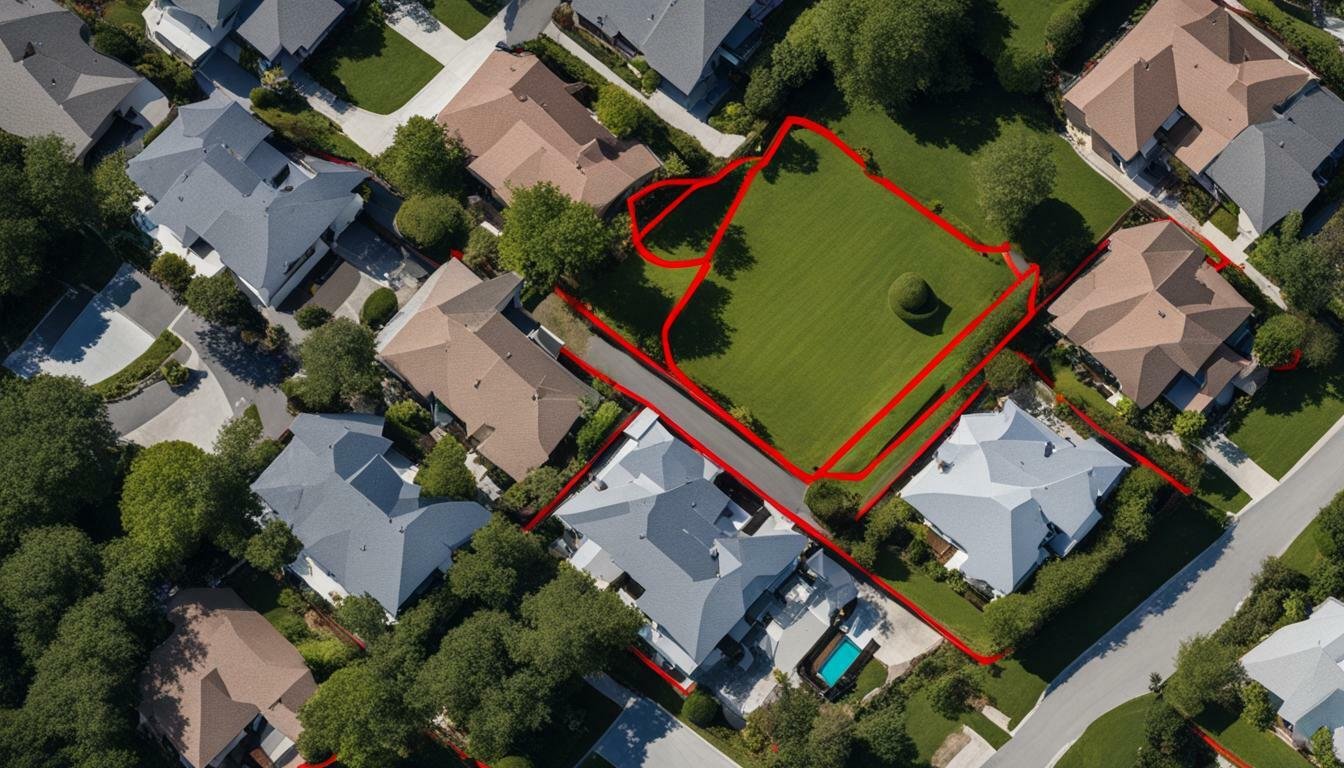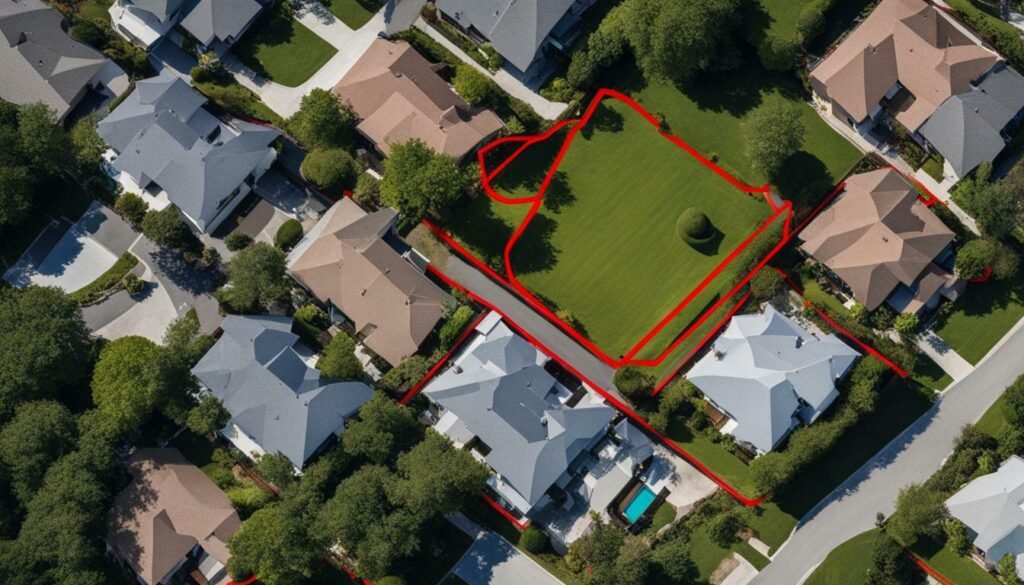 Encroachment is a term used in real estate to describe a situation where a property owner violates the boundaries of another property owner. It is a common issue that can arise during real estate transactions, and it can have significant legal implications. Encroachment can occur by a structure, physical object, or even overhanging tree branches that cross over another property’s boundary lines without permission.
Encroachment is a term used in real estate to describe a situation where a property owner violates the boundaries of another property owner. It is a common issue that can arise during real estate transactions, and it can have significant legal implications. Encroachment can occur by a structure, physical object, or even overhanging tree branches that cross over another property’s boundary lines without permission.
In order to understand encroachment, it is essential to have a clear understanding of property boundaries and the laws that govern them. Property boundaries are the lines that separate one property from another. These boundaries are established by surveys and legal documents and must be respected by all parties involved in a real estate transaction. Encroaching on another person’s property boundaries can lead to legal disputes and claims of trespassing or adverse possession.
Therefore, understanding the law related to encroachment in real estate is crucial. Encroachment can pose significant challenges when buying or selling a property. This article will provide a comprehensive overview of encroachment in real estate, from its definition to its legal implications, with a focus on identifying and resolving such disputes.
Contents
- 1 Understanding Property Boundaries
- 2 Definition and Types of Encroachment
- 3 Identifying Encroachment Issues
- 4 Legal Implications of Encroachment
- 5 Resolving Encroachment Disputes
- 6 Conclusion
- 7 FAQ
- 7.1 Q: What is encroachment in real estate?
- 7.2 Q: How does encroachment occur?
- 7.3 Q: What are the legal implications of encroachment on property boundaries?
- 7.4 Q: How can encroachment be identified?
- 7.5 Q: What are the different types of encroachment?
- 7.6 Q: What are the legal consequences of encroachment?
- 7.7 Q: How can encroachment disputes be resolved?
Understanding Property Boundaries
In real estate transactions, clearly defining property boundaries is crucial. Property boundaries determine the extent of a property owner’s rights and responsibilities, such as land usage, zoning, and taxes.
Boundaries can be established through legal documents, such as deeds or land grants, and are often marked on the land itself by physical structures like fences or walls. However, disputes can arise when boundaries are unclear or shifting, leading to conflict between neighbors or legal action.
The Role of Surveys
To avoid boundary disputes, many real estate transactions include a survey to establish property lines and ensure that structures such as buildings, fences, and driveways are within the property’s boundaries. A surveyor will evaluate the property and provide a detailed map, outlining the specific dimensions and boundaries of the property.
It’s important to note that surveys may not always provide a definitive solution to boundary disputes, as they are not infallible and can be challenged in court. However, a survey can serve as a helpful starting point for resolving a dispute or negotiating with a neighbor.
Common Boundary Disputes
Boundary disputes can arise for a variety of reasons, such as unclear legal descriptions, inaccurate surveys, or changes to the land over time. Common boundary disputes include:
- Encroachment: when a physical structure, such as a fence, tree, or building, extends over the property line into a neighbor’s property.
- Trespassing: when one party enters or uses a neighbor’s property without permission or legal right.
- Boundary line confusion: when the exact location of a property line is unclear or disputed by neighbors.
If a boundary dispute cannot be resolved through negotiation or mediation, legal action may be necessary. Therefore, it’s important to consult with a real estate attorney early in the dispute resolution process.
Definition and Types of Encroachment
Encroachment is the unauthorized extension of a property owner’s land beyond their established boundaries onto an adjacent property. There are several types of encroachment, including encroachment by structures, which occurs when a building or fence extends beyond the property line, as well as encroachment by physical objects, such as overhanging tree branches or underground roots.
Encroachment by structures can also occur when a property owner builds on and obstructs an easement, which is a legal right for someone else to use a portion of their land, such as for access to a nearby property or utility lines.
It is important to note that encroaching structures may not always be visible, making it imperative to conduct careful property inspections and surveys to identify any potential encroachment issues.
| Type | Description |
|---|---|
| Structural Encroachment | Occurring when a building or fence extends beyond the property line, or when a property owner obstructs an easement. |
| Encroachment by Objects | Involving physical objects, such as overhanging tree branches or underground roots, that extend beyond a property’s boundary. |
Understanding the types of encroachment is crucial for identifying potential issues and determining appropriate legal action in real estate transactions.
Identifying Encroachment Issues
Recognizing potential encroachment issues can be crucial in ensuring a smooth real estate transaction. Here are some signs to look out for:
- Neighbor’s structures, such as fences or sheds, that appear to be on or near your property line
- Overhanging tree branches that cross into your property
- Physical objects, such as vehicles or equipment, that intrude on your property
It’s important to conduct property inspections to confirm any potential issues. Surveys and property records can also be used to establish property boundaries.
Consulting with legal professionals can help to confirm the presence of encroachment and determine the best course of action. Taking proactive measures to address these issues can prevent costly legal disputes down the line.
Legal Implications of Encroachment
Encroachment can have serious legal consequences for real estate transactions. When one property owner encroaches on another’s property, it may constitute trespassing, which is the intentional entry onto another person’s property without their permission. Trespassing can result in claims for damages, which can include compensation for any harm caused by the encroachment.
In some cases, encroachment can lead to adverse possession. Adverse possession occurs when someone gains legal ownership of a property by using it openly and continuously for a period of time, typically several years. If the encroaching property owner can prove adverse possession, they may be granted ownership of the portion of the property that they encroached upon.
To prevent legal issues related to encroachment, it is essential to disclose any potential encroachment before completing a real estate transaction. It is the responsibility of the property owner to provide accurate information and disclose any potential encroachment to avoid any future legal consequences.
Resolving Encroachment Disputes
When encroachment issues arise, it is important to take action to resolve the dispute as soon as possible. Depending on the circumstances, there are several methods of resolution to consider.
Negotiation: The first step in resolving an encroachment dispute is often through negotiation. This involves communicating with the encroaching party to reach a mutually agreed-upon solution. Negotiation can be a quick and cost-effective way to resolve a dispute.
Mediation: If negotiation is unsuccessful, mediation can be a viable option. Mediation is a form of alternative dispute resolution that involves a neutral third party to facilitate a resolution between the parties. Mediation can be less formal and less expensive than going to court.
Lawsuits: If negotiation and mediation are unsuccessful in resolving the dispute, the next step is to consider legal action. This may involve filing a lawsuit to seek damages or to enforce property rights. Going to court can be time-consuming and expensive, so it is important to weigh the costs and benefits before pursuing this option.
Regardless of the method used to resolve the dispute, it is important to seek legal advice from an experienced real estate attorney. A real estate attorney can help navigate the complex legal issues surrounding encroachment and provide guidance on the best course of action.
Conclusion
The issue of encroachment in real estate can have significant legal and financial ramifications. By understanding the concept of encroachment and the importance of clearly defining property boundaries, property owners can take proactive measures to prevent and address potential disputes.
In summary, encroachment occurs when a structure, object, or vegetation crosses over the established property boundary of a neighboring property. It is essential to identify potential encroachment issues early on, through property inspections or legal resources such as surveys and property records.
Failure to address encroachment can result in legal consequences, such as trespassing claims or adverse possession. It is important to seek legal advice when dealing with encroachment disputes and to consider various resolution methods such as negotiation, mediation, and lawsuits.
Overall, encroachment in real estate is a topic that should not be overlooked. By taking proactive measures and seeking legal guidance when necessary, property owners can protect their property rights and avoid potential legal and financial complications.
FAQ
Q: What is encroachment in real estate?
A: Encroachment in real estate refers to the unauthorized use, occupation, or intrusion onto another person’s property. It occurs when a structure, object, or even a part of the land extends beyond the boundaries of a property.
Q: How does encroachment occur?
A: Encroachment can occur in various ways. It may happen unintentionally during construction or landscaping projects, or it can be intentional, where one party deliberately extends their property onto another’s.
Q: What are the legal implications of encroachment on property boundaries?
A: Encroachment can lead to property boundary disputes and legal complications. It may result in trespassing, potential claims for damages, or even the establishment of adverse possession rights by the encroaching party.
Q: How can encroachment be identified?
A: Encroachment can be identified through careful property inspections, surveys, and the review of property records. Signs of encroachment may include structures, objects, or vegetation extending beyond property lines.
Q: What are the different types of encroachment?
A: There are several types of encroachment, including encroachment by structures (such as buildings, fences, or driveways), encroachment by physical objects (such as vehicles or storage), and encroachment by overhanging tree branches or roots.
Q: What are the legal consequences of encroachment?
A: The legal consequences of encroachment can include potential claims for damages, injunctions to remove encroaching structures or objects, and even the loss of property rights through adverse possession claims.
Q: How can encroachment disputes be resolved?
A: Encroachment disputes can be resolved through negotiation, mediation, or, if necessary, legal action. Seeking the guidance of legal professionals and obtaining proper documentation, such as surveys and property records, is essential in resolving these disputes.
- Can you become a millionaire by investing in real estate? - November 7, 2023
- What form of AI is most commonly used in real estate? - November 5, 2023
- What is the AI real estate market forecast? - November 3, 2023
